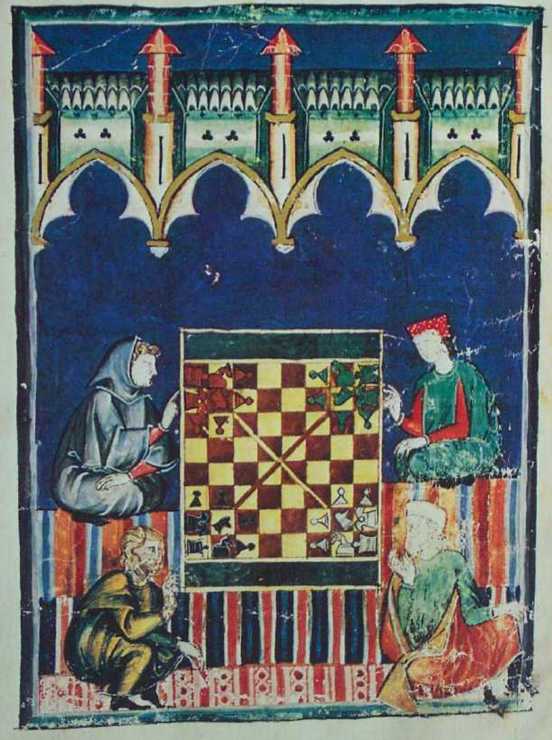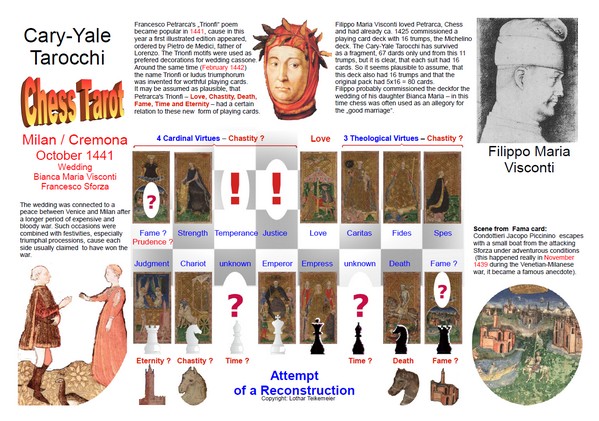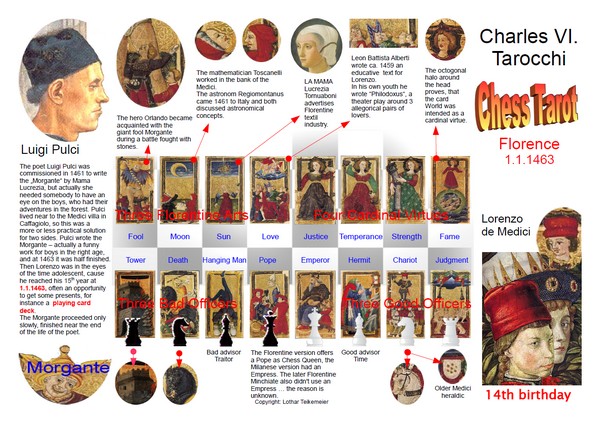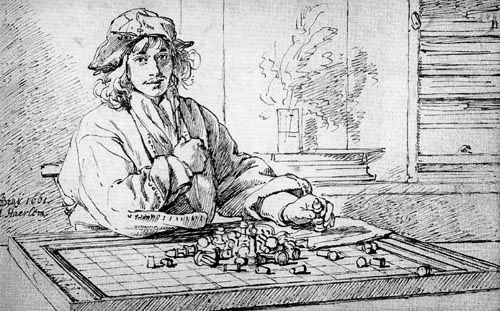Jim Schulman wrote:I haven't played "mental-games" with the "must trump" condition; that will change things when used in combination with capturing valuable cards rather than tricks: you can draw outstanding trumps by leading worthless cards in a long suit, forcing others to waste their trumps. That is a real game changer, similar to a running a squeeze in bridge, and would encourage strategic play. Is the "must trump" a feature in the earliest rules?
This "MUST trump" Tarot rule is quite uncommon for German players ... :-) ... actually it reduces some freedom, but opens the chance to make high trumps worthless. ... :-) ... somehow as the Italian play in soccer games.
I think, that this "way of thinking" developed from a Chess version, which is already mentioned in the chess book of Alfonso the wise (1284).
I wrote about it here ...
viewtopic.php?f=11&t=460&start=57
Between other chess variants Alfonso also noted this:
A chess variant, which is called "forced" or "game of the damsels"
And we wish next to tell of the game which they call forced. And this is because even though it
may be played according to each player’s will, in it there is also to be an element of force because
a man goes against his will losing his best piece to his opponent’s worst, willing or not by putting
it on a square where the other is forced to capture it, according to the movement of the piece
against which it is put. And this game is arranged just the same as the first and the pieces move
and capture each other in that same way except that there is in addition the forced capture. And
therefore those that play it are to be knowledgeable so that they do not put their best pieces in a
position where they are to give them up to lesser and more lowly pieces. Because in this lies all
the wisdom of this game and its play. And because of this force which we described, they call it
the forced game. But because some tell that the damsels first invented it overseas, they call it the
game of the damsels.
This is of special interest, as the later Tarot card games differed from other trump card games, that trumping was "forced" (you MUST capture, if you can) ... as in the chess game of the damsels. "invented it overseas" likely meant, that this version developed in England (?).
In this text I suspected, that ... " "invented it overseas" likely meant, that this version developed in England (?)".
Nowadays I assume, that the passage of "damsels in overseas" might also mean "Ladies from Italy" (seen from the Alfonso perspective in Spain). This would make sense, as some elements in the early Trionfi card development look so, as if they are invented by women or for the "taste of women".
This rule naturally ALSO reduces the game possibilities (and so makes chess possibly a little "less interesting") ... at least it results in a quicker game, cause the figures disappear more quickly from the board.
The thread, to which the linked article belongs, is "Chess variants 14th/15th century", a fine collection mainly made myself and the second most successful thread in the researcher Forum (with more than 15.000 views). I note this, cause I'm rather sure, that most Tarot researchers from here do not often visit it ... the many views should come from visitors of the web, who search something about chess and not of Tarot.
Well, I think, that the hypothesis, that Trionfi decks developed from Chess, makes sense, and then I started this thread just to help up my own small knowledge about chess history. Some persons here made critical remarks about my Chess-Tarot connection ... "monstrosity", "self-evidently ridiculous", "The folly is so apparent as to beggar rational analysis: JUST LOOK! Look at a chess set. Look at the Tarot trumps. They are very different types of subject matter", "self-evident nonsense" ... :-) ... which is naturally wind for the mills of my mind, cause I well remember a sentence of good old Lao-Tse, who argued, that, if nobody laughs about something, it isn't worth to be researched (well, just my own free interpretation of the sentence, and the original sentence is old Chinese, and that's always a matter of interpretation). Independent from the condition, if my interpretation is correct or not, I made mostly good experiences with the personal practice of the advised strategy ... :-).
So I wasn't interested in the major chess history of the common versions, but in the study of possible variants. Actually Chess figures on playing cards would be naturally ALSO part of the variants. Actually I would assume, that there were more Chess variants, than we know of. When we gather chess documents, it's similar to documents of Trionfi cards, the authors just tell about Trionfi cards and Chess, but forget the structural information like the composition of figures and board size and the game rules. So researchers run against the mental wall, that they read Trionfi (and they think, that this means the Tarot version they're thinking of) and they read of chess (and they think, that it should be the version, which they know). Well, with some experience the researcher knows, that the modern version of chess is different from the medieval version, but that, what is commonly taken as the medieval version is also under the risk to be another form of misunderstanding. So for instance these versions are all European, but they are different ...

4 person chess or Chess of the four seasons
Courier Chess at 8x12 board with 24 figures for each player.

Same Courier chess
Chess game with either 15x8 or 16x8 board and 32 figures for each player. 16th century.
Short-assize versions, said to be from 16th century
Sort of short-assize version 1398, used by Evrart de Conty.
Generally we've to calculate a lot of "unknown Chess versions", which also existed, most of them likely not of big relevance (just experimentation with rules), but some might have had some real manifestation, but had left the world without reporting historical document. Well, likely a situation comparable to playing card research.
The change from medieval chess to modern chess occurred between 1470-1530 ... so it's said. Well, it's not accidental, but causal, that just in this same period occurred the distribution of the book printing press. Likely one can claim, that unification of different chess rules to a "modern chess" followed the increase of international communication by the use of a new media ... very logical. In the moment, when enough people could publish their work in a well distributed book and enough people could read it - then in a natural way a sort of unification took place. On the long run the book printing press reduced the different forms of language use, a unified form of writing was searched and found, at least for the national languages. When later radio and TV spread their words, spoken dialects (still strong in 1950 and 1960's in Germany for instance) started to disappear. So Chess development stands in a series of other unification processes caused by the invention of book printing, and when we look at our special problem "development of the Tarocchi game", so it would be against the probability, if we would assume, that Trionfi cards never took part in the global unification process, but were ready in the 1430s and weren't changed by the otherwise revolutionary changes of the late 15th century. Actually we see a name change of the game in 1505, an indication, that something has changed with the game.
It seems probable, that different trump games from different Europeans regions collided in the course of the "international unification processes" and keeping up the "Trionfi game name" would have caused confusion (in the case, that Latin "triumphare" was used also elsewhere for game procedures in a different manner).
The man, who likely caused the name change (Alfonso d'Este in 1505) had been before (1504) on a journey through Europe, which had led him to the French and to the English court and, considering the general card playing fever of this time, he likely made experiences with playing card habits in other countries (in France was played very much and England just had detected card playing as a wonderful habit). He named his game "Tarochi" after this journey - that's, what we know from the documents.
Well, we live in another new form of mighty unification process called internet. In my pre-internet life I collected and used dictionaries. This habit has disappeared, and likely everybody can identify, why. Further I've learned in the new time a lot about different languages (another part of the unification process) - I think, everybody knows, why. In my youth I put a lot of energy in learning Go, a Japanese board game. Nowadays the youth can play with their i-phone against each high-quality games, even, when they don't understand the rules. Life changes.
Earlier my interests to publish were limited "just by money" (books take money). Nowadays I only have to understand some internet technology and I can produce, whatever I want.
In the standard chess histories, the period from 1300 to 1500 was seen as the the death throes of the old game (with the limited queen and bishop). By 1500, the new rules have emerged in Spain and the game revives.
.....
In this situation, you would expect a wild proliferation of different rules for chess (like "faerie chess" variants today). The professionals and top players would be open to a rule change, but only a change that preserved the strategic refinement of the old game. That only happens with the contemporary rules that empowered the queen and bishop, and turned the board into a far more rapidly lethal, but still fairly calculable, arena (you can look ahead a lot further playing in the old rules).
In the retrospective chess histories, it is the pros of each era who finally determine the rules of serious chess.
Lucena is usually credited as the key professional to create modern chess; which is almost entirely a Spanish phenomena (since they inherited the Moorish pros)
Well ... I made some observations during my Chess escapades. For instance this one: Cessolis wrote his chess moralization very vaguely "around 1300". The book later became "very successful" and the translations spread through Europe. Cessolis individualized the pawns, they got professions, although this specifications (all what we know of European chess variants) had no consequence ... the rules weren't influenced by this idea, European just had the same function in the game.
But in Persia existed at least since c. 1340 a version (without problems possibly much older), which used specified pawn and in this case, the specifications really had influence on the development of the game and each pawn had an individual movement (though only, if they reached the final promotion field). The game later was called Tamerlane chess, cause Tamerlane (the ruler of a rather big gigantic Persia since c. 1370 till 1406) loved this game. Tamerlane was more or less of Mongol descend. In 1406 he embarked to reconstruct the fallen Mongol Empire in China. The gigantic operation suffered by bad weather and Tamerlane died.
Tamerlane was far in Persia and Cessolis in Genova. China was not so far, as one might expect, as Marco Polo fought for a Venetian army and became prisoner in Genova (1298/1299). And about Cessolis we don't know much, but it's known, that he worked for the inquisition. Traditionally the inquisition worked on and with "prisoners". It was in Genova, that Marco Polo had time to report about his journey to China, and he dictated to another prisoner, who was able to write.
For contemporary Europeans Persia had been the motherland of Chess - for instance for Meister Ingold in 1432. so it naturally had been interesting, how the Persians played chess.
In 1450 Persia again was a big Empire, but the ruler dynasty had changed and the new regent, Uzun Hassan, had much less Mongolic descend than Tamerlane before. But naturally the Mongolic past couldn't disappear totally in a few years. Uzun Hassan had a vital interest: to fight against the Ottomans, which were dangerous neighbors. As he himself alone had been too weak to attempt it alone, he developed a greater interest to cooperate with others, who had similar difficulties with the Ottomans. The Ottomans took Constantinople in 1453, so Western Europe started to get worries. Uzun Hassan sent delegations, likely already in the 1450s, already in the time, when a Spanish pope reigned in Rome (1455-1458). During this time a "real crusade" took place 1457, led by St. Capristan and Hunyadi (if Uzun Hassan participated in the background, I don't know). In 1463, when Venice declared war on the Ottomans, an Uzun Hassan delegation was in Venice. The diplomatic connection was handicapped by the far distance. Travels from Persia to Venice and vice versa could take a half year. Pope Pius attempted a crusade, but the attempt more or less died with his death 1464. Paul Paul II. gathered a lot of money, but stayed inactive. Pope Sixtus had enough money and organized a crusade army (also Aragon participated, so somehow also Spain) , which took Smyrna. In "triumph" they returned in spring 1473 to Rome, but the real military success was considered rather small. But in this period a sort of super-ambassador had been in Italy, who visited various places, between them Montefeltro in Urbino. The date is not clear, might be something between 1472-74. Both,the ambassador appear together on a picture.

The ambassador was a Spanish Jew, who worked as physician for Uzun Hassan. I don't know, if he also was in Spain, a least he wouldn't have had difficulties to communicate with Spanish delegates, which he surely met. When his visit in Italy might have had only small success, he was very successful at the court of Hungary and at the Balkan.
The visit of the ambassador to Montefeltro is interesting, cause Montefeltro developed in the period 1474-1476, so following the visit, a personal interest in mathematical structures with "28" as the key number. "28" is the key number in the Tamerlane chess, which has 28 figures at each side and a board with 112 fields. Montefeltro for instance had "28 pictures" in his famous studiolo. More you find at:
viewtopic.php?f=11&t=494&p=8097&hilit=montefeltro#p8097
Montefeltro had in 1474 the climax of his career, He became duke of Urbino, and got various honors, for instance he became member in the English knight order of the garter and member of the order of the Ermelin in Naples. He was Condottiero Nr. 1 in Italy. in this time. He became very rich.
He likely became obsessed with "knight culture". And Chess played a role in knight culture, in Germany it belonged to 7 installed capabilities of the knight, beside swimming, horse riding, sword fighting and some other practical arts, useful for a knight. So there's some plausibility in the idea, but it's only an idea.
But fact is, that Mongolic chess variants (Shatar / Hia-Shatar) existed, which had already a strong Queen (the Mongols had another expression) and a strong bishop (the Mongols had another name) with long steps ... at least 500 years old, as the not very precise sources claim. The information about these rules is confusing in the internet, with contradictions. Nobody seems to be very sure about the rules 500 years ago, and it's assumed, that the rules floated. Nowadays Mongol people show a general chess enthusiasm.
Another fact is, that the Mongols crushed Persia in 13th century, and then took for some time a strong influence there. There were known for a "quick war" and could move their forces large distances in short time. It's somehow typical, that this special quality of the Mongol army was imitated in their Chess games.
Chess generally imitated real battles or the real usual state of the medieval time. A quick Queen or a quick Bishop wouldn't have been realistic in the European world. In Mongolic chess these figures had other names (Oueen = Snow Panther / Bishop = Camel), which didn't know these limitations and indication of slow movement.
You mention Lucena, but Lucena (* 1465) was too young to have initiated the "new rules", which are assumed to have originated in the early 1470s. Lucena was of importance in the larger distribution of the new rules.
Lucena's father ...
http://es.wikipedia.org/wiki/Juan_de_Lucena
... had been in Italy and was in Rome at least in the time of Pope Pius II, when he still wasn't pope (so before 1458) ...
Juan de Lucena fue sacerdote y vivió en Roma algún tiempo al servicio del cardenal Enea Silvio Piccolomini, futuro papa Pío II
,
... who made strong movements towards a new crusade. I'm handicapped by my not very small Spanish, but I would imagine, that he might have had insight in these secret discussions between Persian and Western diplomats, which had the aim to organize a coordinated fight against the Ottomans. Lucena himself is later called a "converso", son we likely have to imagine Lucena's father as a Jew with abilities to communicate in Arabian language. An early connection to the later "super-diplomat", the Spanish Jew and physician at the court of Uzun Hassan, can't be excluded.
All this is difficult to research for me ... I'm limited in my Spanish ... but I sense, that European chess (whatever this had been in the period 1450 - 1470)) had been confronted by the large Persian view on chess and it's very much variants in Eastern countries. It was discussed a political alliance of high importance, so acts of politeness against
this very specific "Persian culture" was natural ... a way to understand the other side was urgent in the given moment. Well, the problem was in the begin vivid in "internal diplomatic cycles", but these discussions and their connected circumstances reached naturally also the next level, which in Italy would have been the Condottieri and in other European countries other capable men of high nobility with knowledge about the use of swords and canons. So we have the Congress of Mantova in 1459, inviting many men of this specific class. A class, which traditionally had implied the game of chess as part of their military culture.
******************
I hope, that you see, that the whole question has some dimensions. The pressure of the Ottomans on European culture endured later a few centuries. It was at least very strong till Vienna and its first coffee-houses with the paid chess players ... :-)
First Venice had a war from 1463 - 1479 with h Ottomans. The connection to the Persian throne broke down, when Uzun Hassan had died in 1478. The early big danger of the Ottomans was stopped in 1481 for some time with the death of the conqueror of Constantinople, Mehmed II.
*****************
In my opinion Italy had made a very specific Chess development with the production of Trionfi decks, which imitated chess in their trump series. As a result we have games with 16 trumps (Michelino deck, Cary-Yale Tarocchi, Charles VI deck). Stronger Persian Chess influence started some time after Uzun Hassan had taken the throne. For the Trionfi deck development I personally see, that the decks got 20 trumps instead of 16 ... around 1465.
Well, that's "Uzun Hassan time". In the Eastern chess in Persia normal 8x8 chess versions were considered to be "small chess" and the larger versions with 10x10 (also called decimal chess) were considered "more noble" and of higher value.
The Eastern decimal chess versions didn't take a big influence on European chess, the usual board-form 8x8 was the most popular. For Trionfi card history, which likely was strong connected to noble cycles, however, it became a deciding step: 20 special cards instead of 16 and later 22 special cards became the general form.


























